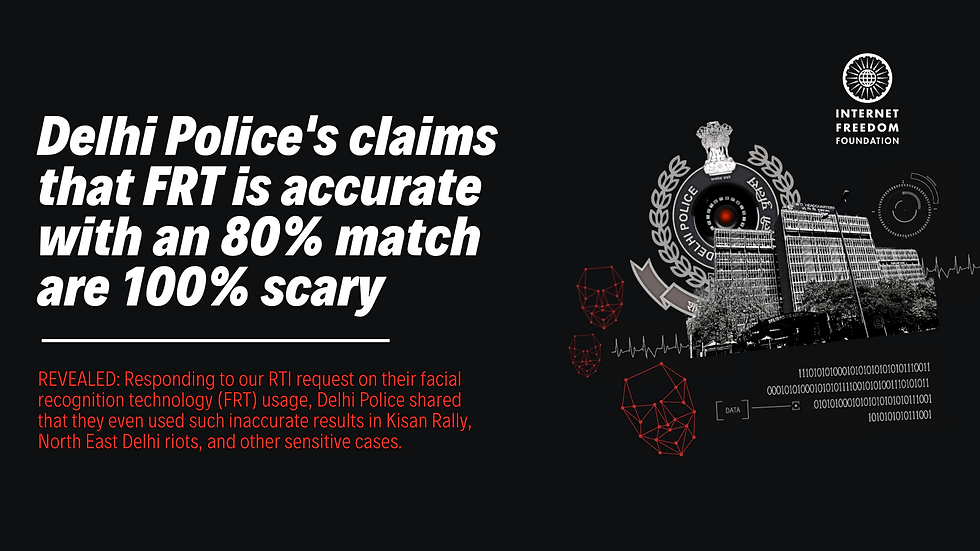the report came out based on an RTI reply and research of an independent research group,According to RTI replies received from Delhi Police, the purchase was allowed under a 2018 order of the Delhi High Court. Sadhan Haldar vs NCT of Delhi. W.P.(CRL) 1560/2017 , However, in 2018 itself, the Delhi Police told the Delhi High Court that the accuracy of their technology was only 2% and was “not good”.
Also in 2018. Home minister shri amit shah ji publicly said during a speech tha over 1900 rioters of delhi were identified using FRTs.

With time tech has advanced and at present 2022 it is working efficiently to fight crime and comb off offenders from crowd if required to do so


Through replies dated July 25, 2022, the Delhi Police has finally revealed some of the information we had sought in our requests.
The Delhi Police used FRT to investigate the North East Delhi riots, the Kisan Rally (Lal Qila Riots), and the Jahangir Puri Riots cases.
The accuracy of their FRT depends on light conditions, distance, and angle of face. All matches above 80% similarity are treated as positive results while matches below 80% similarity are treated as false positive results which require additional “corroborative evidence”.
The Delhi Police uses convict photographs and dossier photographs under S.3 & 4 of the Identification of Prisoners Act, 1920.
In response to our query whether the FRT data will be used as evidence, the Delhi Police has replied in the affirmative however has refused to share further information citing S. 8(1)(h) of the RTI Act.
The Delhi Police has also indicated that FRT is “being widely used in solving cases specially pertaining to heinous cases and missing persons and also in Unidentified Bodies and Unidentified person found (sic)”.
In response to our query pertaining to whether any privacy impact assessment was carried out, the Delhi Police responded in the negative, however they have stated that “the privacy of any citizen is sacrosanct and the Delhi Police is well aware of that”.
The use of this tech is also against principles of Privacy as setup in KS Puttaswamy case on Right to privacy
Globally FRT(Facial recognition tecchnology) Laws:
The GDPR(General Data Protection Regulation (EU GDPR) ), under Art. 5, puts into place certain principles based on which personal data can be processed. These principles are ‘lawfulness, fairness and transparency’, ‘purpose limitation’, ‘data minimisation’, ‘accuracy’, ‘storage limitation’, ‘integrity and confidentiality’ and ‘accountability’.
Further, under Art. 9, the GDPR prohibits the processing of personal data revealing biometric data for the purpose of uniquely identifying a natural person.
What is Facial Recognition?
Facial recognition is a database matching system that uses an algorithm to identify a person based on a digital map of their face. There are two main applications for this technology:
The first is identification verification. In this, a face map is obtained to match a person’s photo in a database to validate their identity.
Second, there is identity 1-n identification. In which a face map is made from a photo or video and then matched with the whole database to find out who is in the photo or video.
The technological operations of FRT comprise the following:
Collection/acquisition of images,
Face detection,
Normalisation,
Feature extraction,
Storage of raw data and features (face templates),
Comparison,
Use for primary purpose (e.g. identification of a wanted person),
Potential reuse for other purposes,
Potential disclosure,
Deletion of raw data and/or features (face templates).
In the Automated Facial Recognition System (AFRS), the large database (containing photos and videos of peoples’ faces) is used to match and identify the person.
Three Principles of use of FRT,
Verification [one to one comparison] This involves the comparison of two biometric templates to verify a person’s identity. The SmartGate system used at the airport is a good example of this use.
Identification [one to many comparison] This involves the comparison of an individual’s biometric template to another stored in a database. An example of this is the automated FRT system used by police forces which can extract facial images from video footage and compare against a ‘watchlist’.
Categorisation FRT may also be used to extract information about particular characteristics of a person such as race, sex and ethnicity. This is also known as ‘face analysis.’8 This analysis could predict or profile a person based on their facial image. It does not specifically identify a person, but if characteristics are inferred from a facial image and potentially linked to other data (e.g. location data), it could de facto enable the identification of an individual.
Refernce links:




Comments